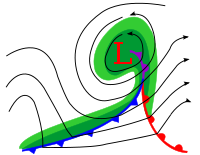- Occluded front
-
An occluded front is formed during the process of cyclogenesis when a cold front overtakes a warm front. When this occurs, the warm air is separated (occluded) from the cyclone center at the Earth's surface. The point where the warm front and the occluded front meet (and consequently the nearest location of warm air to the center of the cyclone) is called the triple point.[1]
There are two types of occlusion, warm and cold. In a cold occlusion, the air mass overtaking the warm front is cooler than the cool air ahead of the warm front, and plows under both air masses. In a warm occlusion, the air mass overtaking the warm front is not as cool as the cold air ahead of the warm front, and rides over the colder air mass while lifting the warm air.
A wide variety of weather can be found along an occluded front, with thunderstorms possible, but usually their passage is associated with a drying of the air mass. Additionally, cold core funnel clouds are possible if shear is significant along the cold front. Occluded fronts are indicated on a weather map by a purple line with alternating semicircles and triangles pointing in direction of travel. Occluded fronts usually form around mature low pressure areas.
References
- ^ Djurić, D: "Weather Analysis". Prentice Hall, 1994. ISBN: 0-13-501149-3.
Schultz, D. M., and G. Vaughan, 2011: Occluded fronts and the occlusion process: A fresh look at conventional wisdom. Bull. Amer. Meteor. Soc., 92, 443–466, ES19–ES20.
See also
- Extratropical cyclone
- Surface weather analysis
- Weather fronts
- Cold front
- Warm front
External links
Categories:- Weather fronts
Wikimedia Foundation. 2010.

